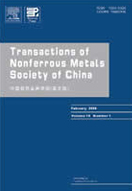Effects of Al and N plasma immersion ion implantation on surface microhardness, oxidation resistance and antibacterial characteristics of Cu
(1. Shanghai Key Laboratory of Materials Laser Processing and Modification,
School of Materials Science and Engineering, Shanghai Jiao Tong University, Shanghai 200240, China;
2. Department of Physics and Materials Science, City University of Hong Kong, Hong Kong 999077, China;
3. Changzhou EGing Photovoltaic Technology Co., Ltd., Changzhou 213200, China)
School of Materials Science and Engineering, Shanghai Jiao Tong University, Shanghai 200240, China;
2. Department of Physics and Materials Science, City University of Hong Kong, Hong Kong 999077, China;
3. Changzhou EGing Photovoltaic Technology Co., Ltd., Changzhou 213200, China)
Abstract: Al and N were introduced into copper substrate using plasma immersion ion implantation (PIII) in order to enhance its hardness and oxidation resistance. The dosage of N ion is 5×1016 cm-2, and range of dosage of Al ion is 5×1016-2×1017 cm-2. The oxidation tests indicate that the copper samples after undergoing PIII possess higher oxidation resistance. The degree of oxidation resistance is found to vary with implantation dosage of Al ion. The antibacterial tests also reveal that the plasma implanted copper specimens have excellent antibacterial resistance against Staphylococcus aureus, which are similar to pure copper.
Key words: copper; plasma immersion ion implantation; nanoindentation; oxidation resistance; antibacterial properties

